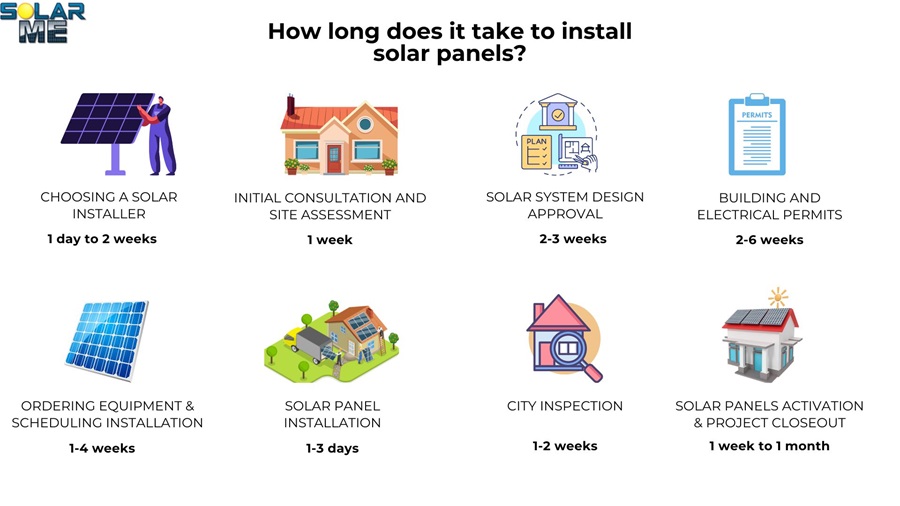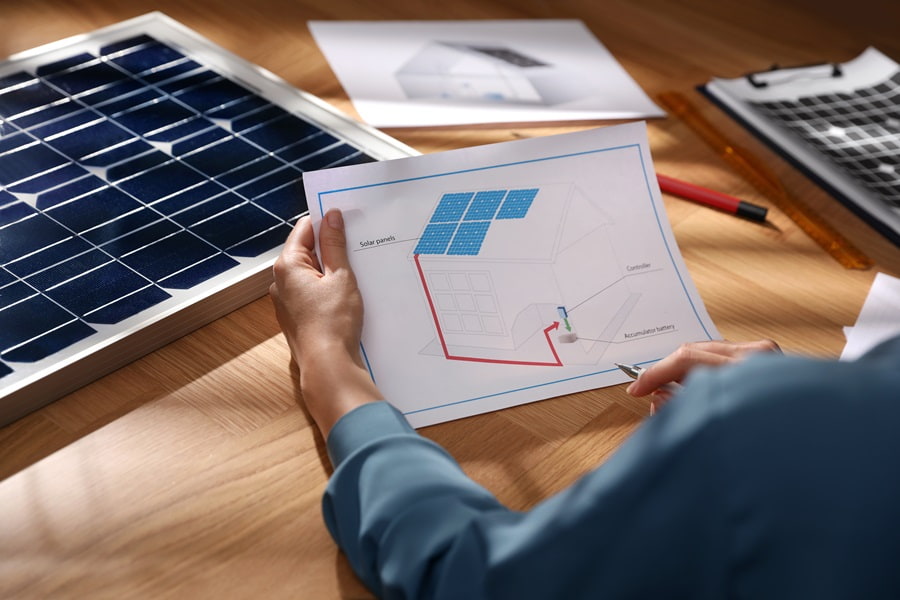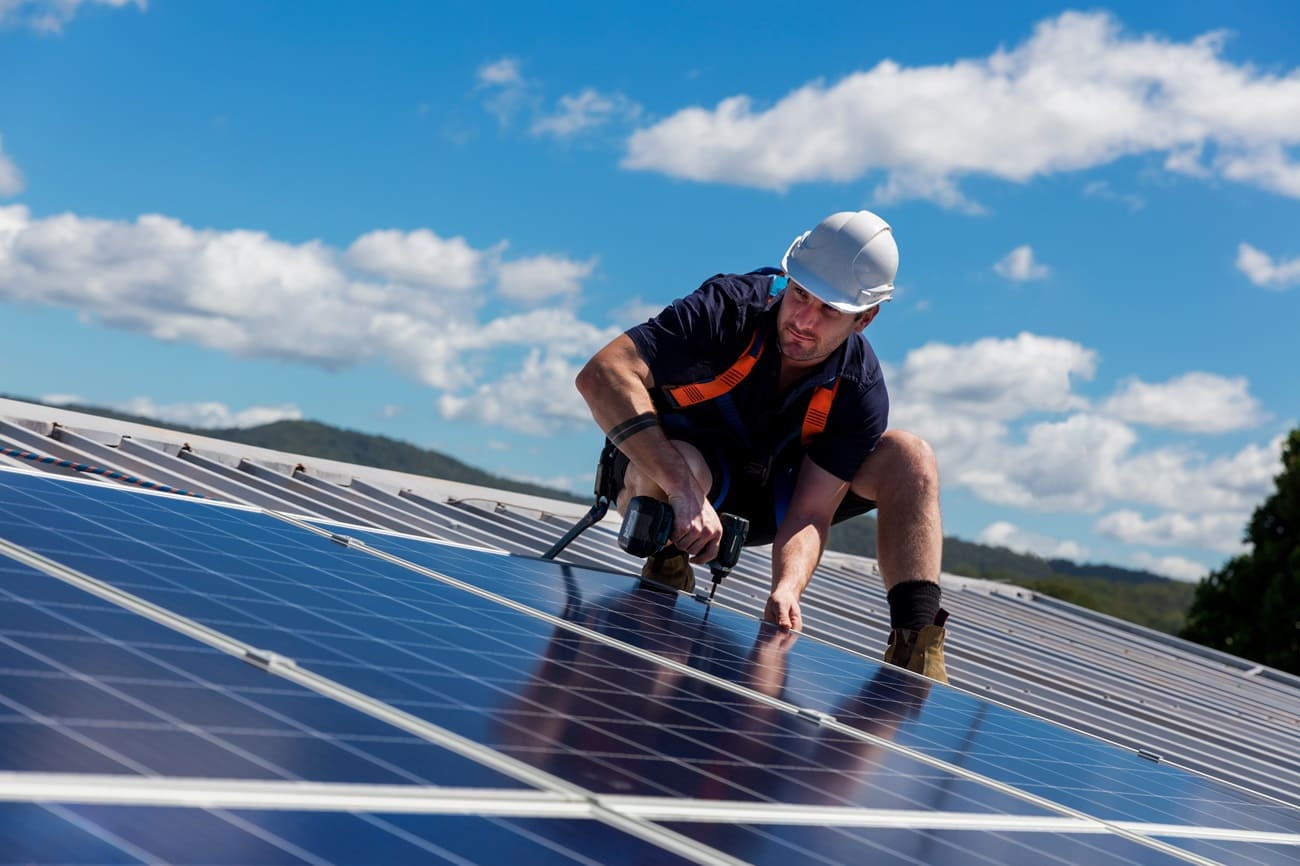Installing solar panels is a vital step towards clean, sustainable energy and one of the best ways to gain energy independence. If you’re getting solar panels, you should understand the installation timeline for efficient solar power adoption.
This guide describes the timeline, from initial consultation to solar panel activation. Stay tuned for an in-depth exploration of the solar panel installation process from our team at Solar Me to guide you smoothly through each phase.

Before Installation: 6 Weeks – 4 Months
Before solar panel installation, several preliminary actions are required. These include selecting a solar installer, having a consultation, conducting a site evaluation, designing the system, obtaining necessary permits, and procuring the equipment.
Choosing a Solar Installer: 1 Day – 2 Weeks
The first step in your solar panel journey, and arguably the most critical, is to choose a reputable solar panel installer. Depending on the market you’re in, this can take anywhere from a few days to a couple of weeks, depending on the level of competition in your area. In New Jersey, there is an abundance of solar companies and the quality of their service varies significantly. A bad installation can end up costing you more than it can ever save you. That’s why it’s worth taking a little extra time to make sure the installer you’re hiring has a proven track record.
To find a reliable installer, seek out companies with a strong history (more than 5 years in business at a minimum), and a track record of positive customer reviews. It's also wise to solicit quotes from multiple solar installers in your area to compare options. While aiming for at least three quotes is good practice, getting more can offer a wider range of perspectives. However, it’s worth remembering that high-quality solar panel installation can’t be cheap.
Initial Consultation and Site Assessment: 1 Week
Scheduling an initial consultation is the first step. You’ll meet with a solar expert, typically at your home. During the consultation, you can discuss the solar panel installation requirements, express your expectations, and address any concerns you might have. These may include the best-suited solar power system options for your residence, the pricing structure, and financing alternatives. Moreover, site assessment is a key element of the consultation.
The site assessment is a comprehensive evaluation to ensure your home is ready and suitable for solar panel installation. This process is key in understanding how to fit a solar panel effectively on your property. This assessment focuses on aspects such as the condition and structure of your roof, its dimensions, ventilation locations, and potential shading, as well as the capacity and state of your existing electrical service panel.
The primary objective of this site assessment is to confirm that your rooftop is structurally sound to bear the weight of the solar panels and to verify that your electrical panel is equipped to handle the projected energy output. Additionally, the expert assessor will evaluate the roof's orientation and exposure to sunlight to ensure optimal positioning for the solar panels, thereby maximizing sunlight capture and energy production. This is crucial in determining how to fit a solar panel most efficiently.
During the assessment, the professional will also gather necessary information, take precise measurements of the roof, assess sunlight exposure, and identify any required repairs or upgrades to accommodate the solar panels installation. While the actual assessment might take only a few hours, the entire process, including scheduling and preparation, is generally completed within a week, setting a solid foundation for successful solar panel installations.
Solar System Design Approval: 2–3 Weeks

Once your roof is deemed suitable for solar installation, the next step is crafting a customized solar system design tailored to your home's specific needs. This phase involves the expertise of a solar engineer, who will consider various factors such as your electricity usage, local building codes, and utility company requirements to create a system that not only fits your energy needs but also adheres to all regulatory standards.
Typically, the solar project design process spans an average of two to three weeks, though more intricate roof layouts might extend this timeframe slightly. However, even for more complex systems, the design stage rarely exceeds four weeks. The engineers use the data from the site assessment to refine the designs and ensure compliance with local codes. Part of this process includes verifying and finalizing the solar building plans, which will then be submitted for city permits.
Building and Electrical Permits: 2–6 Weeks
Obtaining permits is an essential stage in the solar panel installation process, often taking between 2 to 6 weeks. This phase involves acquiring the necessary building and electrical permits, which vary depending on your locality. Some areas might require specific solar permits, while others need a standard set of construction permits. Your installer plays a crucial role here, handling the majority of the paperwork and liaising with the relevant city departments and utility companies.
This process includes managing documents for utility interconnection, net-metering applications, and any rebate incentives. While your involvement is generally minimal, occasionally providing signatures, staying informed about the process is important. Installers with established relationships with local authorities can often expedite this process.
Throughout this stage, you’ll receive updates from your solar company about the status of your application, keeping you informed and prepared for the upcoming solar panels work.
Ordering Equipment and Scheduling Installation: 1–4 Weeks
After your permits are approved, the process moves forward to the ordering of equipment and scheduling the installation, a phase that can range from 1 to 4 weeks. At this stage, the availability of equipment plays a crucial role. If your installer has the necessary solar panels and related equipment in stock, the solar process can start promptly, potentially reducing wait times significantly.
However, even with equipment readily available, scheduling the solar installations itself might require some flexibility. The installer's availability to come to your home and set up the system might extend the timeline, typically by at least a week, to accommodate their schedule.
On the other hand, if the installer needs to order specific equipment for your system, this can lengthen the process considerably. Delivery of solar equipment, subject to availability and supply chain factors, could take a few weeks. In some instances, delays in the solar supply chain could further extend this waiting period.
Throughout this phase, effective communication with your installer is key. They’ll keep you informed about the estimated arrival of equipment and coordinate with you to schedule a suitable installation date. This step, although it might involve some waiting, is critical to ensure that all necessary components are in place to install solar panels successfully.
Solar Panel Installation: 1–3 Days

This is the quickest part of the entire solar board installation process. Once your installation date is set, a specialized team arrives with all the necessary equipment for solar power installation for the home, including solar panels, inverters, and wiring. A typical residential solar installation can be completed within 4-6 hours, depending on the system's size.
The process begins with the crucial setup of electrical wiring to integrate the solar panels with your home's power network. Then, solar panels are meticulously mounted onto a pre-installed racking system on your roof, marking a significant step in the solar board installation. For standard systems, this part of the installation is usually completed within a single day.
However, more complex projects, such as those involving a larger number of panels, diverse roof layouts, or additional components like battery systems, may extend the timeline of the solar system installation over two to three days. Factors like the complexity and size of the system play a role in the installation duration. Regardless of these variables, the goal is always a swift, seamless installation that leads to your home's successful transition to clean, sustainable solar energy.
After Installation: 2 Weeks – 6 Weeks
After your solar panels are installed, your journey is one step closer to fruition. While the physical installation of solar panels marks a significant milestone, there are crucial post-installation tasks that play a pivotal role in ensuring the seamless operation and functionality of your solar energy system.
City Inspection: 1–2 Weeks
Following the installation of your solar panel system, a crucial phase awaits – the inspection, which typically spans 1 to 2 weeks. During this time, the team initiates contact with the city authorities to schedule an inspection by a city building inspector. This inspection is essential to verify that your solar panels are installed safely and in accordance with local building codes and approved engineering plans.
The significance of this inspection cannot be overstated, as it ensures the safe and correct functioning of your solar energy system, essentially a power plant on your roof. Some areas may require additional inspections, like those from the Fire Department or utility companies, depending on local regulations.
During the inspection, the technician will be present to facilitate the process and address any immediate corrections if needed. The duration can vary and it’s influenced by factors such as the inspection backlog and location. In some cases, it may take up to a week or longer if corrections are necessary.
Solar Panels Activation & Project Closeout: 1 Week – 1 Month

With your solar installation complete and the sun's power ready to be harnessed, the next phase is solar panel activation and project closeout, which typically spans from 1 week to 1 month. During this stage, your solar energy system will be fully operational and you will be equipped with all the information you need to make the most of it.
You’ll be provided with comprehensive instructions on how to activate your solar panels, allowing you to begin generating clean, sustainable energy for your home. Additionally, you'll gain access to a user-friendly monitoring portal that gives you real-time insights into your system's performance and energy production.
To enhance your satisfaction, a closeout meeting with the operations team will be scheduled. This is your opportunity to ask any lingering questions about your solar system and its maintenance. Emphasizing transparency, the goal is to ensure you feel confident and well-informed about your investment in solar energy.
Factors Impacting Solar Panel Installation Time
The timeline from choosing a solar panel installer to post-installation depends on several critical factors:
- Roof Repairs: If your roof requires maintenance or repair work before solar panel installation, the additional permitting and construction can extend the overall project duration.
- Permitting: Obtaining necessary permits can be time-consuming, varying by location and administrative efficiency. Delays in permit processing extend the timeline.
- Electrical Upgrades: Electrical upgrades, like transitioning from a 125A to a 200A electrical panel, require permits and inspections, contributing to delays.
- Unpermitted Structures or Service Panels: City approval typically requires either obtaining proper permits for all work or rectifying/removing any unpermitted components.
- Equipment Availability: Certain solar panels, inverters, and critical solar components may become unavailable by your scheduled installation date. If specialized parts are required and not readily in stock, additional time will be needed for your solar energy system installation.
- Weather Conditions: Inclement weather, such as heavy rain, snow, or extreme temperatures, can halt installation due to safety and feasibility concerns. Seasonal weather fluctuations also affect timelines.
Conclusion
As you can tell, solar panel installation is a multi-step process that usually takes from 2 to 5 months to complete. Once your system is operational, it’ll provide your family with clean energy for many years to come.
New Jersey homeowners can trust our experienced team at Solar Me for expertise in solar installation. To take the next step towards energy independence, reduced utility bills, and a smaller carbon footprint, contact us today!





